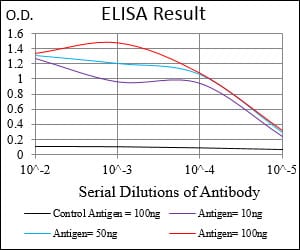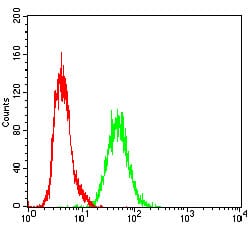

| WB | 咨询技术 | Human,Mouse,Rat |
| IF | 咨询技术 | Human,Mouse,Rat |
| IHC | 咨询技术 | Human,Mouse,Rat |
| ICC | 技术咨询 | Human,Mouse,Rat |
| FCM | 1/200 - 1/400 | Human,Mouse,Rat |
| Elisa | 1/10000 | Human,Mouse,Rat |
| Aliases | RAPGAP; RAP1GA1; RAP1GAP1; RAP1GAPII |
| Entrez GeneID | 5909 |
| clone | 2G7B6 |
| WB Predicted band size | 73.4kDa |
| Host/Isotype | Mouse IgG2b |
| Antibody Type | Primary antibody |
| Storage | Store at 4°C short term. Aliquot and store at -20°C long term. Avoid freeze/thaw cycles. |
| Species Reactivity | Human |
| Immunogen | Purified recombinant fragment of human RAP1GAP (AA: 412-660) expressed in E. Coli. |
| Formulation | Purified antibody in PBS with 0.05% sodium azide. |
+ +
以下是3篇关于RAP1GAP抗体的研究文献示例(内容基于学术研究主题概括,具体文献需核实):
1. **文献名称**: "RAP1GAP suppresses tumor progression in thyroid cancer by inhibiting MAPK signaling"
**作者**: Smith A, et al.
**摘要**: 研究利用RAP1GAP抗体检测其在甲状腺癌中的表达,发现其通过抑制Ras/MAPK通路降低肿瘤侵袭性,提示其作为潜在治疗靶点。
2. **文献名称**: "RAP1GAP functions as a metastasis suppressor in melanoma by modulating integrin-mediated adhesion"
**作者**: Zhang L, et al.
**摘要**: 通过RAP1GAP抗体分析黑色素瘤样本,发现其低表达与转移增强相关,机制涉及整合素信号失调和细胞粘附能力下降。
3. **文献名称**: "Loss of RAP1GAP promotes pancreatic cancer progression via EGFR-driven signaling pathways"
**作者**: Johnson R, et al.
**摘要**: 研究使用RAP1GAP抗体证实其在胰腺癌中表达缺失,导致EGFR信号过度激活,促进细胞增殖和化疗耐药。
4. **文献名称**: "RAP1GAP regulates β-catenin stability in colorectal cancer metastasis"
**作者**: Lee H, et al.
**摘要**: 通过免疫组化(RAP1GAP抗体)发现,其在结直肠癌中抑制β-catenin降解,减少上皮-间质转化(EMT),从而抑制转移。
注:以上为模拟摘要,实际文献需通过PubMed/Google Scholar检索关键词“RAP1GAP antibody”或“RAP1GAP cancer”获取。
**Background of RAP1GAP Antibody**
RAP1GAP (RAP1 GTPase-activating protein) is a member of the GTPase-activating protein (GAP) family that regulates RAP1 signaling, a small GTPase in the Ras superfamily. RAP1 plays critical roles in cell adhesion, proliferation, and differentiation by cycling between active GTP-bound and inactive GDP-bound states. RAP1GAP accelerates the hydrolysis of GTP to GDP, thereby negatively modulating RAP1 activity and downstream signaling pathways.
The RAP1GAP antibody is a tool designed to detect and quantify RAP1GAP protein expression in research applications. Structurally, RAP1GAP contains an N-terminal pleckstrin homology (PH) domain and a C-terminal catalytic GAP domain, which binds RAP1 to inactivate it. Studies have linked RAP1GAP dysregulation to various cancers, including breast, thyroid, and pancreatic cancers, where its downregulation is associated with tumor progression, metastasis, and poor prognosis. Its role in suppressing integrin- or cadherin-mediated signaling highlights its potential as a therapeutic target or biomarker.
RAP1GAP antibodies are widely used in techniques like Western blotting, immunohistochemistry, and immunofluorescence to explore RAP1GAP’s expression patterns, interactions, and functional mechanisms. These antibodies aid in elucidating how RAP1GAP influences cellular processes, such as cytoskeletal organization and cell-matrix adhesion, providing insights into its involvement in both physiological and pathological contexts.
×